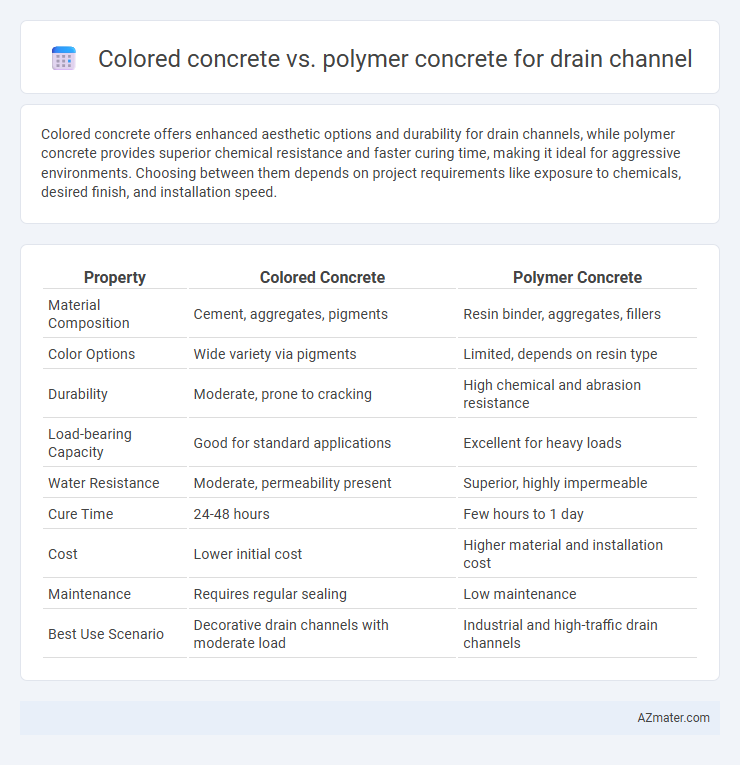Colored concrete offers enhanced aesthetic options and durability for drain channels, while polymer concrete provides superior chemical resistance and faster curing time, making it ideal for aggressive environments. Choosing between them depends on project requirements like exposure to chemicals, desired finish, and installation speed.
Table of Comparison
| Property | Colored Concrete | Polymer Concrete |
|---|---|---|
| Material Composition | Cement, aggregates, pigments | Resin binder, aggregates, fillers |
| Color Options | Wide variety via pigments | Limited, depends on resin type |
| Durability | Moderate, prone to cracking | High chemical and abrasion resistance |
| Load-bearing Capacity | Good for standard applications | Excellent for heavy loads |
| Water Resistance | Moderate, permeability present | Superior, highly impermeable |
| Cure Time | 24-48 hours | Few hours to 1 day |
| Cost | Lower initial cost | Higher material and installation cost |
| Maintenance | Requires regular sealing | Low maintenance |
| Best Use Scenario | Decorative drain channels with moderate load | Industrial and high-traffic drain channels |
Introduction to Drain Channel Materials
Drain channels require durable materials with high resistance to chemical corrosion and mechanical wear. Colored concrete offers aesthetic appeal and moderate strength, suitable for urban landscaping and pedestrian areas. Polymer concrete excels in chemical resistance, tensile strength, and rapid curing, making it ideal for industrial and high-load drainage systems.
Overview of Colored Concrete
Colored concrete offers enhanced aesthetic appeal by integrating pigments directly into the concrete mix, providing durable, vibrant surfaces ideal for drain channels exposed to weather and traffic. Its color consistency and long-lasting resistance to fading or wear make it a preferred choice for visible infrastructure elements requiring both functionality and design. Unlike polymer concrete, colored concrete maintains traditional concrete properties such as compressive strength and thermal stability while allowing customization through a wide range of pigment options.
Overview of Polymer Concrete
Polymer concrete is a composite material consisting of aggregates bonded with polymer resins, offering superior chemical resistance and high tensile strength compared to traditional cement-based concretes. Its rapid curing time and exceptional durability make it ideal for drain channels exposed to harsh environmental conditions and heavy loads. Unlike colored concrete, polymer concrete provides enhanced impermeability and reduced maintenance needs, ensuring long-term performance in infrastructure applications.
Key Material Differences
Colored concrete for drain channels primarily consists of cement, aggregates, pigments, and water, offering high compressive strength and aesthetic versatility but may be prone to cracking under heavy loads or freeze-thaw cycles. Polymer concrete incorporates resins such as polyester or epoxy with aggregates, providing superior chemical resistance, enhanced durability, and faster curing times compared to traditional colored concrete. The key material difference lies in the binder composition--cementitious for colored concrete versus resin-based for polymer concrete--directly influencing their mechanical properties, resistance to environmental factors, and application suitability.
Strength and Durability Comparison
Colored concrete for drain channels offers excellent compressive strength typically ranging between 25 to 40 MPa, ensuring robust load-bearing capacity in urban infrastructure. Polymer concrete exhibits superior durability due to its chemical resistance and lower permeability, which significantly reduces degradation from water, chemicals, and freeze-thaw cycles. The enhanced bond strength and corrosion resistance of polymer concrete extend the lifespan of drain channels, making it a more resilient choice compared to traditional colored concrete.
Resistance to Chemicals and Weather
Colored concrete offers moderate resistance to chemicals and weather, making it suitable for typical drain channel environments where exposure is not extreme. Polymer concrete exhibits superior chemical resistance against acids, alkalis, and salts and withstands harsh weather conditions including freeze-thaw cycles, making it ideal for highly corrosive or exposed drainage scenarios. The enhanced durability and low permeability of polymer concrete significantly extend the lifespan of drain channels in aggressive chemical or environmental conditions.
Aesthetic Options and Design Flexibility
Colored concrete offers a wide range of pigmentation options, allowing drain channels to blend seamlessly with various architectural styles and outdoor environments while providing consistent UV resistance for long-lasting color. Polymer concrete features superior design flexibility due to its ability to be molded into intricate shapes and textures, enabling customized aesthetic patterns and enhanced surface finishes that mimic natural stone or other materials. Both materials support innovative drainage channel designs, but polymer concrete excels in achieving complex, decorative profiles without compromising structural integrity.
Installation Process and Maintenance
Colored concrete for drain channels involves a straightforward installation with standard curing times and requires sealing to maintain color vibrancy and prevent surface wear. Polymer concrete offers faster installation due to its quick curing properties and superior chemical resistance, significantly reducing maintenance needs in corrosive environments. The choice depends on project timelines and long-term durability demands, with polymer concrete excelling in rapid deployment and minimal upkeep.
Cost Analysis and Lifecycle
Colored concrete offers lower upfront costs compared to polymer concrete, making it a budget-friendly option for drain channels with standard stress conditions. Polymer concrete, while initially more expensive due to advanced materials, provides superior chemical resistance and durability, reducing maintenance expenses and extending lifecycle by up to 30% in harsh environments. Lifecycle cost analysis favors polymer concrete in long-term infrastructure projects where reduced repair frequency and enhanced resilience offset the initial premium.
Choosing the Right Concrete for Drain Channels
Colored concrete offers excellent durability and aesthetic appeal for drain channels, with high resistance to weathering and UV exposure, making it ideal for visible or decorative applications. Polymer concrete provides superior chemical resistance and rapid curing times, which is beneficial in industrial environments with exposure to corrosive substances or when quick installation is necessary. Choosing the right concrete depends on factors such as environmental conditions, load-bearing requirements, and maintenance preferences to ensure longevity and performance in drainage systems.

Infographic: Colored concrete vs Polymer concrete for Drain channel
 azmater.com
azmater.com